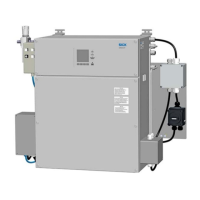16 GMS815P-PS-2G/-3G · Supplementary Operating Instructions · 8016234 V2.0 · © SICK AG
Installation
Subject to change without notice
3.3 Gas connections
3.3.1 Feeding protective gas
The pressurized enclosure system requires a permanent supply of a protective gas.
▸
Feed the protective gas via the protective gas connection (→ p. 11, Fig. 1).
▸
Type and feed parameters of the protective gas → p. 35, §6.8.1
3.3.2 Discharging protective gas
▸
Make sure the protective gas can flow out of the protective gas outlet without opposing
pressure → p. 11, Fig. 1.
▸
Only allow the protective gas to escape into the surrounding area when it is ensured
that the escaping protective gas does not cause
– a suffocation risk for persons
– a poisoning risk when the internal sample gas path has a leak.
CAUTION: Risk of suffocation
Inert gas escapes permanently out of the protective gas outlet (gas free of oxy-
gen). Considerably more inert gas escapes during pre-purging. There is a risk
of suffocation for people in the area when inert gas enriches the surrounding
air.
▸
If the protective gas can cause a risk of suffocation: Discharge the escap-
ing protective gas at a safe location.
WARNING: Hazard through an internal gas leak
If the internal sample gas path has a leak, the protective gas being discharged
contains an unknown concentration of sample gas.
▸
If the sample gas can be dangerous (e.g. dangerous to health or combusti-
ble): Discharge the escaping protective gas at a safe location.
● Connection for Enclosure GMS815P-PS-2G: Thread G 1"
● Connection for Enclosure GMS815P-PS-3G: Thread G
3
/
4
"

